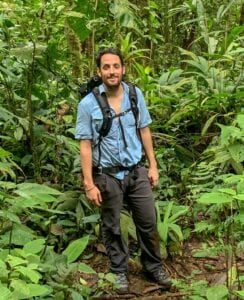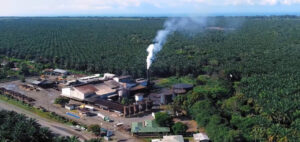Intensification and Industrialization
As the industry grew, palm oil production in Costa Rica became increasingly industrialized. Plantations expanded in size, adopting modern farming techniques and machinery for increased efficiency and productivity. Large-scale plantations became dominant, leading to concerns about the concentration of land ownership and the displacement of small-scale farmers. (6)
Threat to Indigenous Communities
Indigenous communities in Costa Rica are disproportionately affected by palm oil plantations. These communities often face displacement from their ancestral lands, losing cultural heritage, traditional practices, and livelihoods. (8) Palm oil expansion can lead to the violation of indigenous rights, limited access to resources, and marginalization of indigenous populations.
Displacement of Indigenous Populations
The expansion of palm oil production in Costa Rica has led to the displacement and disruption of indigenous populations, particularly those residing in or near areas targeted for palm oil cultivation. The displacement of indigenous communities has had significant social, cultural, and economic consequences.
Palm oil plantations often encroach upon indigenous territories through direct land acquisition or extending their operations into areas traditionally occupied by indigenous communities. This encroachment results in the loss of ancestral lands. Furthermore, it disrupts the connection between indigenous peoples and their territories, affecting their cultural identity and traditional way of life.
Many indigenous communities in Costa Rica have struggled for land rights recognition and legal protection of their territories. The expansion of palm oil production further exacerbates these challenges as the industry competes for land and resources crucial for indigenous populations’ subsistence and cultural practices. Displacement from their ancestral lands can lead to the loss of self-sufficiency, food security and a breakdown of community cohesion.
The displacement of indigenous populations due to palm oil expansion can lead to conflicts and tensions with the palm oil industry, government agencies, and other stakeholders. As a result, indigenous communities often face marginalization, unequal power dynamics, and limited participation in decision-making processes that affect their lands and resources.
Here are some of the common types of conflicts that occur:
Land Disputes: Indigenous tribes in Costa Rica often face conflicts with palm oil plantations over land ownership, land use, and territorial boundaries. Indigenous communities assert their rights to ancestral lands, which may overlap with areas targeted for palm oil expansion. Disputes arise when indigenous land claims are not recognized or respected, leading to tensions and legal battles.
Environmental Impacts: Indigenous communities raise concerns about the ecological impacts of palm oil plantations, such as deforestation, habitat destruction, water pollution, and soil degradation. These impacts threaten the ecosystems that indigenous peoples rely on for their subsistence, cultural practices, and traditional knowledge. Conflicts arise when indigenous communities advocate for sustainable land use and environmental conservation. At the same time, palm oil companies prioritize profit and expansion.
Cultural Disruption: The expansion of palm oil plantations can disrupt indigenous cultures and traditional practices. Indigenous communities have deep cultural ties to their lands, and displacement or land encroachment by palm oil operations can result in the loss of cultural heritage, language, and traditional knowledge. Conflicts arise when indigenous communities fight to preserve their cultural identity and protect their cultural practices from being eroded by the presence of palm oil farms.
Social and Economic Disparities: Palm oil plantations often bring economic disparities and social inequalities to indigenous communities. They can disrupt traditional livelihoods and subsistence practices, increasing poverty, unemployment, and reliance on wage labor. Conflicts emerge when indigenous communities demand equitable benefits, fair compensation, and inclusive development opportunities from palm oil companies and government entities.
Consultation and Participation: Conflicts can arise due to inadequate consultation and meaningful participation of indigenous communities in decision-making processes related to palm oil expansion. Indigenous peoples have the right to free, prior, and informed consent (FPIC) regarding activities that may affect their lands and resources. Conflicts arise between indigenous communities, palm oil companies, and government authorities when these rights are disregarded or insufficiently upheld.
It is important to note that conflicts are not homogeneous across all indigenous communities and palm oil plantations. The nature and intensity of disputes can vary depending on specific local contexts, historical factors, cultural dynamics, and the extent to which indigenous rights are recognized and protected. Efforts to address these conflicts include dialogue, legal actions, advocacy, and initiatives promoting sustainable and socially responsible palm oil practices.
Environmental Impacts of African Palm Plantations
The environmental impacts of African palm farms in Costa Rica and their effects on indigenous communities are significant. (7) (9) Here are some of the critical environmental concerns associated with African palm cultivation:
Deforestation: One of the most pressing environmental impacts is the conversion of natural ecosystems, including forests and other biodiverse areas, into palm oil plantations. As a result, this large-scale deforestation results in habitat loss of many plant and animal species, leading to biodiversity decline and ecological imbalances.
Loss of Biodiversity: Land conversion for African palm farms disrupts ecosystems, reducing species richness and altering ecological dynamics. This biodiversity loss affects indigenous communities that rely on forests products for their livelihoods, cultural practices, and traditional knowledge.
Soil Degradation: Intensive cultivation practices, including agrochemicals and monoculture farming, can lead to soil erosion, degradation, and nutrient depletion. These practices reduce soil fertility and long-term agricultural productivity, impacting farming practices’ sustainability for palm growers and indigenous communities dependent on fertile lands.
Water Pollution: Using agrochemicals, such as pesticides and fertilizers, in palm oil production can contaminate water bodies through runoff and leaching. This pollution affects water quality, negatively impacting aquatic ecosystems, fisheries, and the availability of clean water for indigenous communities and other local populations.
Water Scarcity: African palm requires substantial water for irrigation, which can lead to increased water demand in regions with limited water resources. This demand can exacerbate water scarcity issues, affecting water availability for indigenous communities and other local users, including for drinking, agriculture, and cultural practices.
Greenhouse Gas Emissions: The expansion of African palm farms often involves clearing forests, which releases significant amounts of carbon dioxide into the atmosphere, contributing to greenhouse gas emissions. As a result, it exacerbates climate change, impacting local communities and global environmental consequences.
The exact number of affected acres and people can vary and is subject to ongoing changes due to African palm farms’ expansion and management practices. However, it is estimated that as of 2020, approximately 265,000 hectares (655,000 acres) of land were dedicated to African palm cultivation in Costa Rica. The number of people affected, including indigenous communities, is more challenging to quantify accurately, as impacts can vary depending on proximity to palm oil plantations and specific circumstances.
Health Risks and Occupational Hazards
Costa Rica’s palm oil plantations pose several health risks and occupational hazards to workers employed in the industry. (10) Here are some of the health risks and occupational hazards associated with palm oil plantations in Costa Rica:
Pesticide Exposure: Workers on palm oil plantations may be exposed to pesticides and other agrochemicals used for pest control and plant management. Prolonged or inadequate exposure to these chemicals can lead to acute or chronic health effects, including skin irritations, respiratory problems, neurological disorders, and increased risks of certain cancers.
Chemical Handling: Workers involved in the application and handling of agrochemicals face risks related to improper handling, storage, and accidental exposure. Insufficient training and inadequate protective measures can increase the likelihood of chemical-related injuries or poisonings.
Heat Stress: Palm oil cultivation often occurs in tropical regions with high temperatures and humidity. Workers are exposed to the risk of heat stress, which can lead to heat exhaustion and heatstroke. Inadequate access to shade, hydration, and rest breaks can exacerbate the dangers of working in hot and humid conditions.
Physical Strain: Work on palm oil plantations involves physically demanding tasks, such as manual harvesting, pruning, and maintenance of palm trees. These activities can lead to musculoskeletal disorders, including strains, sprains, and repetitive motion injuries, mainly when workers lack proper training, equipment, or ergonomically designed tools.
Work-related Accidents: Palm oil plantations often use heavy machinery and equipment, such as tractors, chainsaws, and harvesters. Inadequate safety protocols, lack of training, and poor machinery maintenance can result in work-related accidents, including falls, cuts, amputations, and machinery-related injuries.
Respiratory Issues: Workers involved in tasks such as burning vegetation or operating machinery in dusty conditions may be exposed to respiratory hazards. Inhalation of particulate matter, dust, or smoke from fires can lead to respiratory problems, including asthma, bronchitis, and other respiratory disorders.
Infectious Diseases: Palm oil plantations, mainly tropical regions, can serve as breeding grounds for disease-carrying vectors such as mosquitoes and ticks. Depending on the local epidemiological conditions and preventative measures implemented, workers may be at an increased risk of vector-borne diseases, including malaria, dengue fever, and Lyme disease.
Lack of Occupational Health Services: Access to adequate healthcare and occupational health services may be limited in some palm oil plantations, particularly for temporary or informal workers. Limited access to medical care and occupational health monitoring can exacerbate health risks and delay identifying and addressing work-related health issues.
Efforts are underway to promote alternative land uses and conservation practices in response to palm oil expansion’s environmental and social impacts. These initiatives include reforestation programs, agroforestry systems, and the promotion of sustainable livelihoods that incorporate diverse crops, such as organic agriculture or shade-grown coffee.
The relentless expansion of African palm (Elaeis guineensis) in Costa Rica has unleashed an environmental catastrophe of dire proportions. Driven by insatiable economic motives, this invasive crop has wreaked havoc on once-thriving ecosystems, leaving a trail of destruction in its wake.
The sinister origins of this disastrous venture lie with The United Fruit Company, responsible for introducing African palm as a response to the Panama banana plight. Since then, the demand for palm oil, a ubiquitous ingredient in the food, cosmetic, and biofuel industries, has fueled a devastating surge in palm oil plantations worldwide. Costa Rica, with its fertile lands and favorable climate, quickly became a prime target for investors seeking massive profits.
In this hellish pursuit of profit, indigenous communities have suffered the most. Their ancestral lands, rich with cultural heritage and traditional knowledge, have been forcibly seized to feed the insatiable appetite of the palm oil industry. These marginalized communities face a harrowing existence, struggling to survive amidst the wreckage of their once-prosperous lives.
The tales of suffering and misery are countless – a haunting symphony of environmental degradation, social upheaval, and human tragedy. Indigenous populations, dispossessed and displaced, wander aimlessly, severed from their roots and cultural identity.
Amidst this cataclysmic devastation, the health of workers toils in the shadows, sacrificed on the altar of profit. Pesticides and agrochemicals poison the very hands that toil to harvest the bounty of destruction. Lives are shattered, dreams crushed, and hopes abandoned in this unforgiving landscape of palm oil plantations.
It is a bleak reality that demands urgent action. The call for conservation and sustainable land use is no longer an option – it is a desperate cry to save what little remains of Costa Rica’s precious ecosystems. The time for mere dialogue and half-hearted measures is over; decisive action is the only hope for redemption.




